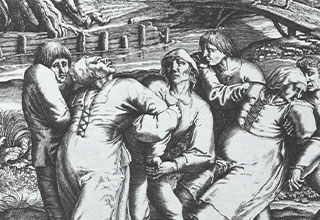21 'Don't Ask How I Know This' Facts
Carly Tennes
Published
09/03/2024
in
creepy
Contrary to our elementary teachers' lessons on Greek soldiers, American revolutionaries, and brave astronauts, history is a whole lot darker than what they taught in school. Just look at the plagues, pillaging, and other creepy details from humanity's roughly 300,000-year existence.
From deadly dancing to the strangely thirsty allure of tuberculosis, here are 21 creepy 'don't ask how I know this' facts.
- List View
- Player View
- Grid View
Advertisement
-
1.
 “One particular (quite small) part of Madagascar have a long lasting belief that a set of twin babies is a curse. A curse big enough they get rid of the babies. It’s been going on for centuries. They used to leave them to die in horrible ways, until international adoption services took care of the situation. That’s how I ended up being Canadian.”“One particular (quite small) part of Madagascar have a long lasting belief that a set of twin babies is a curse. A curse big enough they get rid of the babies. It’s been going on for centuries. They used to leave them to die in horrible ways, until international adoption services took care of the situation. That’s how I ended up being Canadian.”
“One particular (quite small) part of Madagascar have a long lasting belief that a set of twin babies is a curse. A curse big enough they get rid of the babies. It’s been going on for centuries. They used to leave them to die in horrible ways, until international adoption services took care of the situation. That’s how I ended up being Canadian.”“One particular (quite small) part of Madagascar have a long lasting belief that a set of twin babies is a curse. A curse big enough they get rid of the babies. It’s been going on for centuries. They used to leave them to die in horrible ways, until international adoption services took care of the situation. That’s how I ended up being Canadian.” -
2.
 “3 sailors survived the sinking of the USS West Virgina at Pearl Harbor, only to die 16 days later, due to the lack of air. The Navy knew they were there but couldn't get to them.”
“3 sailors survived the sinking of the USS West Virgina at Pearl Harbor, only to die 16 days later, due to the lack of air. The Navy knew they were there but couldn't get to them.” -
3.
 “Dead and mummified Inca rulers would continue to be treated as living and would retain their earthly possessions, including land. So you might have the largest estate in a region be owned and operated by a mummy and their servants. I believe over time it actually turned into a problem because so much land was controlled by the dead. (I learned this from the book 1491).”
“Dead and mummified Inca rulers would continue to be treated as living and would retain their earthly possessions, including land. So you might have the largest estate in a region be owned and operated by a mummy and their servants. I believe over time it actually turned into a problem because so much land was controlled by the dead. (I learned this from the book 1491).” -
4.
 “Mummy Brown paint. Back in the day there was a brown colour in fashion called ‘Mummy Brown’ the paint for it was made by grinding up Egyptian mummies. This went out of fashion once mummies were in short supply. Coupled with ‘Mummy unwrapping parties, mentioned in a previous comment’ the late 19th century was not a good time to be a dead Egyptian noble.”
“Mummy Brown paint. Back in the day there was a brown colour in fashion called ‘Mummy Brown’ the paint for it was made by grinding up Egyptian mummies. This went out of fashion once mummies were in short supply. Coupled with ‘Mummy unwrapping parties, mentioned in a previous comment’ the late 19th century was not a good time to be a dead Egyptian noble.” -
5.
 “Every year, nearly one hundred thousand Japanese vanish without a trace. Known as the johatsu, or the 'evaporated,' they are often driven by shame and hopelessness, leaving behind lost jobs, disappointed families, and mounting debts.”
“Every year, nearly one hundred thousand Japanese vanish without a trace. Known as the johatsu, or the 'evaporated,' they are often driven by shame and hopelessness, leaving behind lost jobs, disappointed families, and mounting debts.” -
6.
 “In the 60s, Germany placed orphans/homeless children with p—philes, under the theory that p—philes had a great interest in taking care of children.”
“In the 60s, Germany placed orphans/homeless children with p—philes, under the theory that p—philes had a great interest in taking care of children.” -
7.
 “War dead have only been buried in special cemeteries in the last 125 years or so. As recently as the civil war bones from the thousands killed in battles were collected, ground up and sold as fertilizer. Some were buried but many were not treated with any sort of respect at all. The battlefield of Waterloo had mass graves that were regularly raided for bones so that only a hand full of graves exist and they were away from the main battle. Not something that gets talked about much but the truth nonetheless.”
“War dead have only been buried in special cemeteries in the last 125 years or so. As recently as the civil war bones from the thousands killed in battles were collected, ground up and sold as fertilizer. Some were buried but many were not treated with any sort of respect at all. The battlefield of Waterloo had mass graves that were regularly raided for bones so that only a hand full of graves exist and they were away from the main battle. Not something that gets talked about much but the truth nonetheless.” -
8.
 “A lot of stuff about kids. One is child abandonment, like in medieval times if people couldn't afford/feed kids they would just...leave them in the forest (which apparently is depicted in Hansel and Gretel).”
“A lot of stuff about kids. One is child abandonment, like in medieval times if people couldn't afford/feed kids they would just...leave them in the forest (which apparently is depicted in Hansel and Gretel).” -
9.
 “Up until 1996 Ireland placed unmarried mothers into ‘Magdalene Laundries’ These women were subjected to what many describe as slavery. They were forced to work without pay, often in laundries or other facilities, under strict supervision and in very harsh conditions. The children born to these mothers were frequently taken from them, sometimes put up for adoption, often without the mother’s consent.”
“Up until 1996 Ireland placed unmarried mothers into ‘Magdalene Laundries’ These women were subjected to what many describe as slavery. They were forced to work without pay, often in laundries or other facilities, under strict supervision and in very harsh conditions. The children born to these mothers were frequently taken from them, sometimes put up for adoption, often without the mother’s consent.” -
10.
 “During WW2, the US produced over 1.5 million purple hearts, which are medals given to military personnel who are killed or wounded in their service. The reason why they produced so many of them is because they were anticipating over a million casualties in a hypothetical invasion of mainland Japan. But because of Japan's decision to surrender after the nukes dropped on Hiroshima and Nagasaki, this never came to be. The medals produced then are still being given to US servicemen to this day, and they're likely not going to need to produce any more of them for a very long time.”
“During WW2, the US produced over 1.5 million purple hearts, which are medals given to military personnel who are killed or wounded in their service. The reason why they produced so many of them is because they were anticipating over a million casualties in a hypothetical invasion of mainland Japan. But because of Japan's decision to surrender after the nukes dropped on Hiroshima and Nagasaki, this never came to be. The medals produced then are still being given to US servicemen to this day, and they're likely not going to need to produce any more of them for a very long time.” -
11.
 “Saturn Devouring His Son by Francisco Goya was actually never named that by the artist himself. This painting wasn't even meant to be seen, and it wasn’t until he left the place where he lived, five years before his death, that it became known. He never explained or spoke about this painting; we basically decided it depicted Saturn devouring his son because it shows a large man eating a smaller body. People believe this painting might have a much more haunting meaning, but we will never know.”
“Saturn Devouring His Son by Francisco Goya was actually never named that by the artist himself. This painting wasn't even meant to be seen, and it wasn’t until he left the place where he lived, five years before his death, that it became known. He never explained or spoke about this painting; we basically decided it depicted Saturn devouring his son because it shows a large man eating a smaller body. People believe this painting might have a much more haunting meaning, but we will never know.” -
12.
 “Back in the Victorian Era people used to take photos of their dead relatives as if they were still alive they'd prop them up dress them nicely and pose with them to create a final memory sometimes it's hard to tell who in the photo is actually dead.”
“Back in the Victorian Era people used to take photos of their dead relatives as if they were still alive they'd prop them up dress them nicely and pose with them to create a final memory sometimes it's hard to tell who in the photo is actually dead.” -
13.
 “George Washington’s teeth were not made of wood. They were made of slaves teeth.”
“George Washington’s teeth were not made of wood. They were made of slaves teeth.” -
14.
 “Apparently some books in the 18th n 19th centuries were bound in real human skin.”
“Apparently some books in the 18th n 19th centuries were bound in real human skin.” -
15.
 “In ancient Egypt, female bodies were often mummified much later after death, in order to make the bodies less attractive to deter necrophilia.”
“In ancient Egypt, female bodies were often mummified much later after death, in order to make the bodies less attractive to deter necrophilia.” -
16.
 “In WW2 the Japanese had a secret bio-warfare research unit called Unit 731 that performed lethal human experimentation, including infecting captives with the plague, STDs, performing vivisections without anesthesia and more. An estimated 200k - 300k people were brutally murdered.”
“In WW2 the Japanese had a secret bio-warfare research unit called Unit 731 that performed lethal human experimentation, including infecting captives with the plague, STDs, performing vivisections without anesthesia and more. An estimated 200k - 300k people were brutally murdered.” -
17.
 “The Black Death. People lost their mind with COVID and its 0.01% death toll. Now imagine a plague that killed 50% of the population. Half of all the people you love and know. Entire communities erased. And you knew it was coming and there was not a single thing you could do against it. We often watch post-apocalyptic movies but we often forget that there has been several real apocalypses in our history (wars, diseases and so on) and most movies are tame compared to them. EDIT: I'm off with my 0.01% but you get my point…”
“The Black Death. People lost their mind with COVID and its 0.01% death toll. Now imagine a plague that killed 50% of the population. Half of all the people you love and know. Entire communities erased. And you knew it was coming and there was not a single thing you could do against it. We often watch post-apocalyptic movies but we often forget that there has been several real apocalypses in our history (wars, diseases and so on) and most movies are tame compared to them. EDIT: I'm off with my 0.01% but you get my point…” -
18.
 “Our modern beauty standards are highly influenced by tuberculosis. Thin waistline, pale face, wide eyes, flushed cheeks, these are all results of consumption (ie TB) and desirable characteristics in a woman. It was nicknamed the ‘romantic disease.’ ‘Consumption, I am aware, is a flattering malady.’ Charlotte Brontë wrote this as she watched her sister get sicker and sicker and whither away.”
“Our modern beauty standards are highly influenced by tuberculosis. Thin waistline, pale face, wide eyes, flushed cheeks, these are all results of consumption (ie TB) and desirable characteristics in a woman. It was nicknamed the ‘romantic disease.’ ‘Consumption, I am aware, is a flattering malady.’ Charlotte Brontë wrote this as she watched her sister get sicker and sicker and whither away.” -
19.
 “One of the creepiest historical facts is the phenomenon known as the ‘Dancing Plague’ in medieval Europe. In 1518 in Strasbourg, France, people started dancing uncontrollably and couldn’t stop, even when they were exhausted. Some dancers died from exhaustion, heart attacks, or strokes. To this day, there is no clear explanation for this phenomenon.”
“One of the creepiest historical facts is the phenomenon known as the ‘Dancing Plague’ in medieval Europe. In 1518 in Strasbourg, France, people started dancing uncontrollably and couldn’t stop, even when they were exhausted. Some dancers died from exhaustion, heart attacks, or strokes. To this day, there is no clear explanation for this phenomenon.” -
20.
 “Volcanic winter of 536. Basically a volcanic or meteor happened in this era and causing a Volcanic winter where the sun was not seen and global temperatures drop probably horrific truly a dark experience especially if science was not prevalent was people might attribute it to deities abandoning or hating them. I also image crops where devastated due to lack of sunlight and possible acid rain.”
“Volcanic winter of 536. Basically a volcanic or meteor happened in this era and causing a Volcanic winter where the sun was not seen and global temperatures drop probably horrific truly a dark experience especially if science was not prevalent was people might attribute it to deities abandoning or hating them. I also image crops where devastated due to lack of sunlight and possible acid rain.” -
21.
 “I don’t think it’s creepy, but the ‘Aswangs’ in the Philippines in the ‘50s. The CIA used the aswang (ghoul, Ig) rhetoric to shut down Philippine rebels. They capture civilians or rebels themselves and kill them in the most gruesome ways, then leave them in the woods or out in the open and claim ‘the aswangs did it.’”
“I don’t think it’s creepy, but the ‘Aswangs’ in the Philippines in the ‘50s. The CIA used the aswang (ghoul, Ig) rhetoric to shut down Philippine rebels. They capture civilians or rebels themselves and kill them in the most gruesome ways, then leave them in the woods or out in the open and claim ‘the aswangs did it.’”
- REPLAY GALLERY
-

- 21 'Don't Ask How I Know This' Facts
“One particular (quite small) part of Madagascar have a long lasting belief that a set of twin babies is a curse. A curse big enough they get rid of the babies. It’s been going on for centuries. They used to leave them to die in horrible ways, until international adoption services took care of the situation. That’s how I ended up being Canadian.”“One particular (quite small) part of Madagascar have a long lasting belief that a set of twin babies is a curse. A curse big enough they get rid of the babies. It’s been going on for centuries. They used to leave them to die in horrible ways, until international adoption services took care of the situation. That’s how I ended up being Canadian.”
21/21
1/21










3 Comments